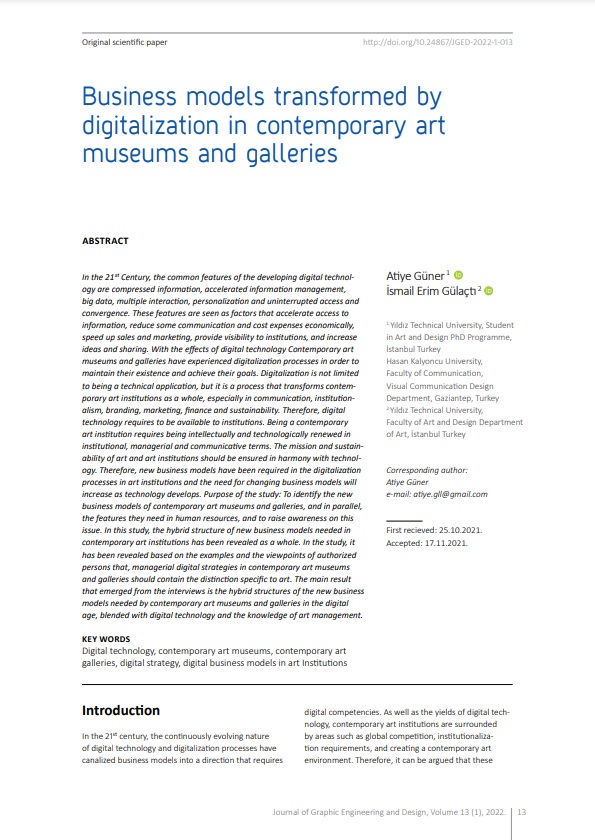Business models transformed by digitalization in contemporary art museums and galleries

Published 2022-03-01
abstract views: 1187 // Full text article (PDF): 1088
Keywords
- Digital technology,
- contemporary art museums,
- contemporary art galleries,
- digital strategy,
- digital business models in art Institutions
How to Cite
Copyright (c) 2022 © 2022 Authors. Published by the University of Novi Sad, Faculty of Technical Sciences, Department of Graphic Engineering and Design. This article is an open access article distributed under the terms and conditions of the Creative Commons Attribution license 3.0 Serbia.

This work is licensed under a Creative Commons Attribution 3.0 Unported License.
Abstract
In the 21st Century, the common features of the developing digital technology are compressed information, accelerated information management, big data, multiple interaction, personalization and uninterrupted access and convergence. These features are seen as factors that accelerate access to information, reduce some communication and cost expenses economically, speed up sales and marketing, provide visibility to institutions, and increase ideas and sharing. With the effects of digital technology Contemporary art museums and galleries have experienced digitalization processes in order to maintain their existence and achieve their goals. Digitalization is not limited to being a technical application, but it is a process that transforms contemporary art institutions as a whole, especially in communication, institutionalism, branding, marketing, finance and sustainability. Therefore, digital technology requires to be available to institutions. Being a contemporary art institution requires being intellectually and technologically renewed in institutional, managerial and communicative terms. The mission and sustainability of art and art institutions should be ensured in harmony with technology. Therefore, new business models have been required in the digitalization processes in art institutions and the need for changing business models will increase as technology develops. Purpose of the study: To identify the new business models of contemporary art museums and galleries, and in parallel, the features they need in human resources, and to raise awareness on this issue. In this study, the hybrid structure of new business models needed in contemporary art institutions has been revealed as a whole. In the study, it has been revealed based on the examples and the viewpoints of authorized persons that, managerial digital strategies in contemporary art museums and galleries should contain the distinction specific to art. The main result that emerged from the interviews is the hybrid structures of the new business models needed by contemporary art museums and galleries in the digital age, blended with digital technology and the knowledge of art management.
Article history: Received (October 25, 2021); Revised (November 16, 2021); Accepted (November 17, 2021); Published online (March 1, 2022)

